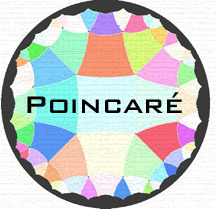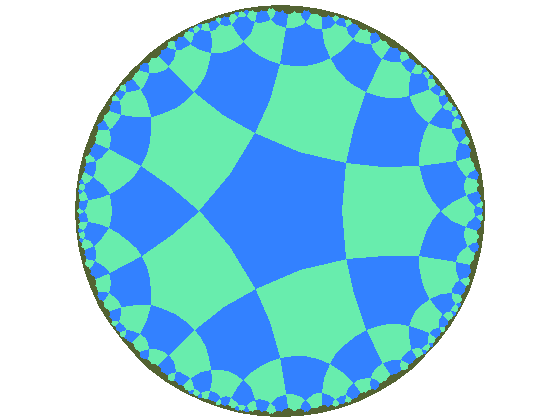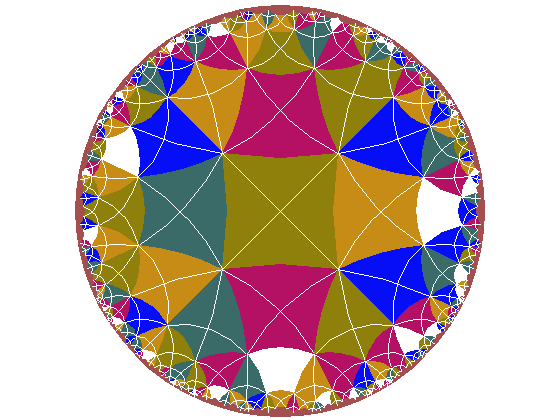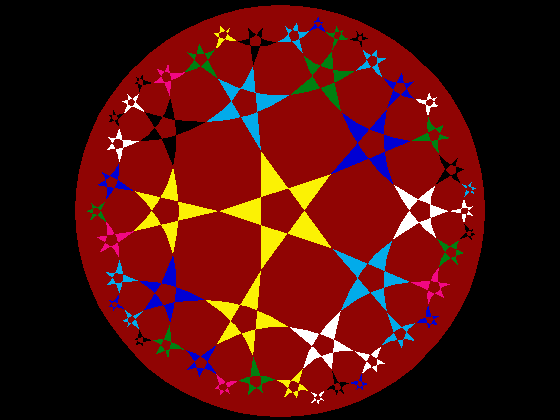Hyperbolic Tessellations
Introduction
 (You can now create your own hyperbolic tessellations. See the Java applet page.)
(You can now create your own hyperbolic tessellations. See the Java applet page.)
A regular tessellation, or tiling, is a covering of the plane by regular polygons so that the same number of polygons meet at each vertex. No doubt, the tessellations of the Euclidean plane are
well-known to you. They are: {3,6} in which equilateral triangles meet six at each vertex; {4,4} in which squares meet four at each vertex; and {6,3} in which hexagons meet three at each vertex. A
notation like {3,6} is called a Schläfli symbol.
There are infinitely many regular tessellations of the hyperbolic plane. You can
determine whether {n,k} will be a tessellation of the Euclidean plane, the hyperbolic plane, or the elliptic plane by looking at the sum
1/n + 1/k. If the sum equals 1/2, as it does for the three tessellations mentioned above, then {n,k} is a Euclidean tessellation. If the sum is less than 1/2,
then the tessellation is hyperbolic; but if greater than 1/2, then elliptic.
You might ask why. For a tessellation {n,k}, there are k regular polygons at each vertex. So the angle at each vertex is 360°/k. Since a regular n-gon has
n equal angles, each being 360°/k, therefore the angle sum is n360°/k.
Now, in the Euclidean plane a triangle has an angle sum of exactly 180°; in the hyperbolic plane less; and in the elliptic plane more. By breaking a polygon into triangles you can determine that
the angle sum of an n-gon is exactly (n - 2)180° in the Euclidean plane; less in hyperbolic; more in elliptic. Therefore, if n360°/k equals
(n - 2)180°, then {n,k} can only be Euclidean; if less, hyperbolic; and if more, elliptic. A little algebra (divide by n360° and add 1/n), and
you see that statement is becomes this: if 1/n + 1/k equals 1/2, then {n,k} can only be Euclidean; if less, hyperbolic; and if more, elliptic.
The Poincaré Disk
The hyperbolic plane can not be metrically represented in the Euclidean plane, but Poincaré described ways that it can be conformally represented in the Euclidean plane. One of those is to
represent the hyperbolic plane as the points inside a disk. For this representation, a straight line in the hyperbolic plane is represented as the part (in the disk) of a circle that meets the
boundary of the disk at right angles. What this means will be clear in the examples displayed below.
The regular tessellation {5,4} of the hyperbolic plane
A regular tessellation is a covering of the plane by regular polygons so that the same number of polygons meet at each vertex. For instance, here is a representation of the tessellation of the
hyperbolic plane by pentagons where four pentagons meet at each vertex, that is, the {5,4}-tessellation.
 It may look like the sides of the pentagons are curved, but that's just because of the representation we're using. In the actual hyperbolic plane they would be straight. Also, the pentagon in the
middle looks larger, but, again, that's due to the representation. You just can't put an infinite plane in a finite region without a lot of distortion.
It may look like the sides of the pentagons are curved, but that's just because of the representation we're using. In the actual hyperbolic plane they would be straight. Also, the pentagon in the
middle looks larger, but, again, that's due to the representation. You just can't put an infinite plane in a finite region without a lot of distortion.
Variations of this
{5,4}-tessellation are also available.
The dual tessellation {4,5} of the hyperbolic plane
For a dual tessellation you reverse the roles of the faces and the vertices.
The dual of a {5,4} tessellation is a {4,5} tessellation, that is, a tiling by
squares, five squares meeting at each vertex. (Here, "square" means regular quadrilateral, a four-sided figure with the same angle at each vertex. It doesn't mean the corners are right-angled, so
maybe "square" isn't the best term.) For this picture, the diagonals are drawn so you can see the straight lines that go off to infinity.

Other regular tessellations are available including {8,4}, {4,8}. {6,6}, {3,12}, and {12,3}.
Some quasiregular tessellations of the hyperbolic plane
A quasiregular tessellation is built from two kinds of regular
polygons so that two of each meet at each vertex, alternately. We'll use the notation quasi-{n,k} to denote a quasiregular tessellation
by n-gons and k-gons.
Every regular tessellation {n,k} gives rise to a
quasiregular tessellation quasi-{n,k} by connecting the
midpoints of the edges of the regular tessellation. In the Euclidean plane
there are just two quasiregular tessellations: quasi-{3,6}
arises from both {3,6} and {6,3}, while
quasi-{4,4} comes from {4,4}. (Of course,
quasi-{n,n} is the same as {n,4}.)
Since there are more regular tessellations of the hyperbolic plane than of
the Euclidean plane, there are more quasiregular tessellations, too. Here are some of them. First a quasi-{5,4} tessellation. The pentagons are in red or yellow while the squares are in orange. It
looks like a plaid disk.
Here's a variation of it where the squares aren't colored, but pentagrams of various colors are placed in the pentagons (the pentagons don't show, either).

A quasi-{3,7} tessellation is built of triangles and heptagons. In the next picture, the triangles are colored a variety of colors while the heptagons are left black.

Other quasiregular tessellations.
Return to the index.
August 1994; Dec 1998
David E. Joyce

Department of Mathematics and Computer Science
Clark University
Worcester, MA 01610
The address of this file is http://aleph0.clarku.edu/~djoyce/poincare/poincare.html





 (You can now create your own hyperbolic tessellations. See the Java applet page.)
(You can now create your own hyperbolic tessellations. See the Java applet page.)